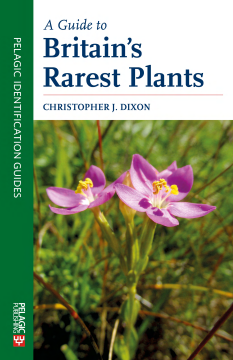
Additional Information
Book Details
Abstract
For centuries, botanists have been drawn to the rarest species, sometimes with dire consequences for the species’ survival. In this book, Great Britain’s rarest flowering plants are discussed in turn, including the stories behind their discovery, the reasons for their rarity, and the work being done to save them from dying out. It is hoped that it will help to throw light on some of the species that normally gain little attention, and foster an appreciation of our most threatened plants.
This guide describes 66 native species of plants that have the most narrowly restricted ranges in Great Britain. These range from continental, warmth-loving species in the south of England to those found only on the highest Scottish mountains. Each species is shown together with its habitat to allow the reader to better understand the ecological context. Other scarce plants in the same area are indicated.
Christopher J. Dixon has a Ph.D. in botany from the University of Vienna. Having written a comprehensive interactive key to the flora of the British Isles, Chris has studied every species found in the wild, from the most abundant weeds to little-known rarities. Drawing on his years of field experience across Europe and his talent for nature photography, Chris has travelled the length and breadth of the country to visit and record rare plants in their natural habitats.
Table of Contents
| Section Title | Page | Action | Price |
|---|---|---|---|
| Cover | A | ||
| Title page | i | ||
| Contents | iii | ||
| Introduction | 1 | ||
| Creeping marshwort | 6 | ||
| Alpine rock-cress | 8 | ||
| Bristol rock-cress | 10 | ||
| Norwegian mugwort | 12 | ||
| Pedunculate sea-purslane | 14 | ||
| Small hare’s-ear | 16 | ||
| Club sedge | 18 | ||
| Starved wood-sedge | 20 | ||
| Large yellow sedge | 22 | ||
| Bristle sedge | 24 | ||
| Perennial centaury | 26 | ||
| Slender centaury | 28 | ||
| Red helleborine | 30 | ||
| Wood calamint | 32 | ||
| Lundy cabbage | 34 | ||
| Strapwort | 36 | ||
| Pigmyweed | 38 | ||
| Leafless hawk’s-beard | 40 | ||
| Lady’s-slipper orchid | 42 | ||
| Starfruit | 44 | ||
| Cheddar pink | 46 | ||
| Diapensia | 48 | ||
| Yellow whitlow-grass | 50 | ||
| Ghost orchid | 52 | ||
| Irish spurge | 54 | ||
| Radnor lily | 56 | ||
| Snowdon lily | 58 | ||
| Alpine gentian | 60 | ||
| Fringed gentian | 62 | ||
| Fringed rupturewort | 64 | ||
| Esthwaite waterweed | 66 | ||
| Land quillwort | 68 | ||
| Pygmy rush | 70 | ||
| Least lettuce | 72 | ||
| Teesdale sandwort | 74 | ||
| Holly-leaved naiad | 76 | ||
| Least adder’s-tongue | 78 | ||
| Military orchid | 80 | ||
| Monkey orchid | 82 | ||
| Bedstraw broomrape | 84 | ||
| Oxtongue broomrape | 86 | ||
| Yellow oxytropis | 88 | ||
| Childing pink | 90 | ||
| Blue heath | 92 | ||
| American pondweed | 94 | ||
| Suffolk lungwort | 96 | ||
| Adder’s-tongue spearwort | 98 | ||
| Sand crocus | 100 | ||
| Scottish dock | 102 | ||
| Drooping saxifrage | 104 | ||
| Triangular club-rush | 106 | ||
| Brown bog-rush | 108 | ||
| Round-headed club-rush | 110 | ||
| Perennial knawel | 112 | ||
| Viper’s-grass | 114 | ||
| Cambridge milk-parsley | 116 | ||
| Fen ragwort | 118 | ||
| Moon carrot | 120 | ||
| Alpine catchfly | 122 | ||
| Downy woundwort | 124 | ||
| Water germander | 126 | ||
| Twin-headed clover | 128 | ||
| Upright clover | 130 | ||
| Spring speedwell | 132 | ||
| Dwarf pansy | 134 | ||
| Fen violet | 136 | ||
| Critical groups | 138 | ||
| Image sources | 143 | ||
| Index | 145 |
